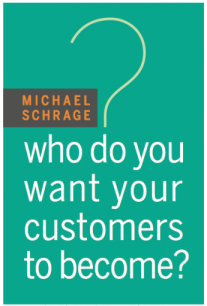In the Connected Age users have real power. They cannot be viewed as a gregarious heard of consumers waiting to be milked for what they have. Instead, value must be co-created and shared. Remember: customers are a company’s most valuable asset.
The practice of UX design inherently seeks to strengthen the value provided to users. With methods such as ethnography, mental models, personas and scenarios, UX strives to view the world from the outside in, rather than the inside out. In doing so, companies can better provide solutions that solve real-world problems and that fit into users’ lives.
But the contemporary practice of UX design doesn’t go far enough. The field implicitly examines and models user behavior as it currently exists. What’s needed is a better way to envision users as they may act.
Enter “The Ask,” a single question outlined by MIT Professor Michael Schrage in his book Who Do You Want Your Customers To Become?Successful innovations, Schrage contends, don’t merely ask users to do something different; they ask them to become someone different.
Here’s an example: George Eastman didn’t just invent inexpensive, automatic camera; he created photographers. His innovation allowed everyday people to do something only trained professionals could previously do with expensive equipment. The result: you, too, can be a photographer. That’s transformational.

With Eastman’s camera (circa 1888) anyone could be a photographer
Another example: Google’s innovation isn’t just a brilliant search algorithm; instead, Google let’s everyone become expert researchers and fact checkers. We’re now all reference librarians with the power of all known human knowledge at our finger tips. Powerful.
Now consider a would-be innovation that failed, such as the Segway. What does the Segway ask us to become? A mad helmeted scientist racing down the sidewalk? Or maybe an authority figure (e.g., policewoman) extending a few feet above other pedestrians? Or maybe just an odd ball on a weird scooter? During its commercial launch, the inventors of the Segway promised to revolutionize transportation and the way people get around cities. But instead it asked us to become somebody we didn’t want to become, and it failed.

The Segway asks us to become someone we don’t want to.
Role of UX
User experience design plays a role in all of the above examples. For instance, Kodak claimed in its early ads: “You push the button, we’ll do the rest.” Their strategy clearly relied on an exceptional user experience, and they delivered on that promise. This resulted in the mass adoption of Eastman’s camera.
Peter Merholz et al. discuss this at length in their book UX strategy Subject To Change. They write:
“[Eastman] recognized that his roll film could lead to a revolution if he focused on the experience he wanted to deliver, and experience captured in his advertising slogan, “You press the button, we do the rest.”
We find a similar pattern with Google: a drop-dead simple user experience with high tolerance for “user error” (e.g., spell correction) makes the service efficient, effective and enjoyable to use. Schrage also highlights the importance of user experience design in his book. He writes:
“Innovations failing to provide good user experiences find difficulty succeeding, no matter what their price…The better the customer experience, the better the odds for innovation success.”
Practically speaking, The Ask doesn’t supersede or replace current tools and methods, rather extends them. It offers a unique perspective on our practices and how they fit into the bigger picture of things. And it can help better shape existing techniques.
Take personas. Often the number and type of personas created for a solution line are determined by traditional (even outdated) segmentation techniques of existing markets. By using The Ask, we can now consider creating personas around the transformational outcomes we envision. Who will our customers become in the future? We can then align our personas to the answers of that question and describe them in terms that address their transformation.
to The Ask.
For more on The Ask, I recommend Michael Schrage’s book. It’s clear and compact, and it’s wholly relevant to core UX work. Written by a leading business thinker, this book highlights the increasing overlap between business and design. The Ask is a simple, reflective query can alter the way we see our users and our
offerings. It increases our ability to create more value through user experience design.
I encourage you to continually ask yourself and the clients you serve, who do we want our customers to become?


Pingback: What I've been reading lately (week 2), by Samuel Ericson